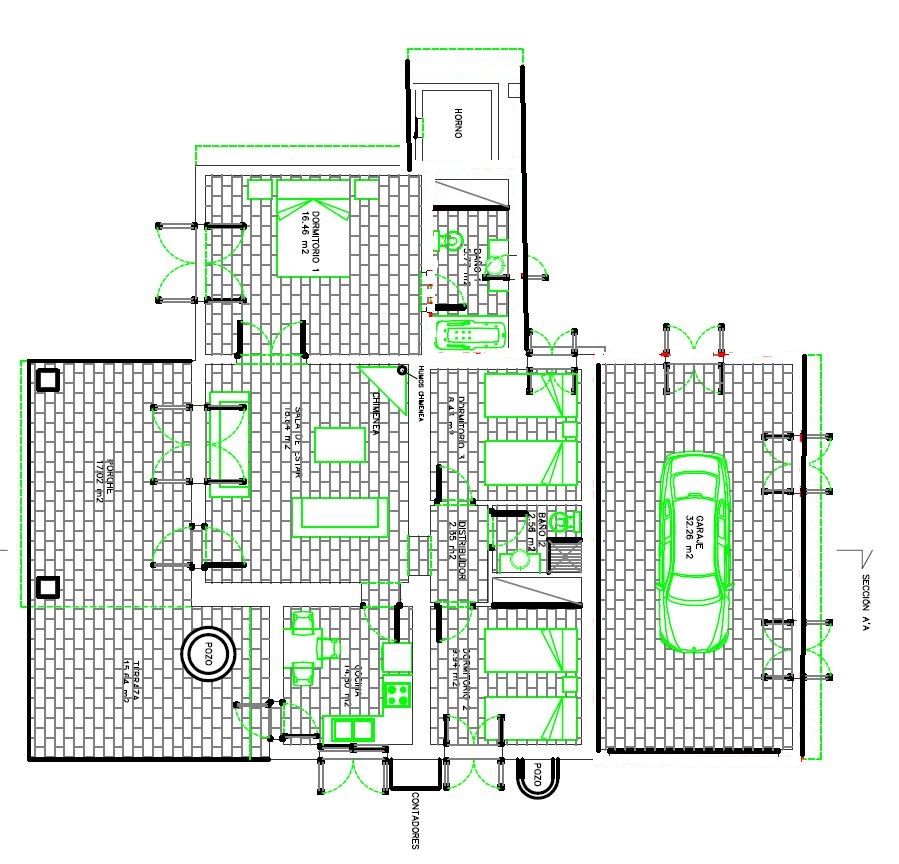in order to be able to build, it is necessary to draw up a project. The project, in accordance with the Ley de ordenación de la edificación (LOE), is drawn up by an architect, who guarantees that it complies with urban planning and technical legality and all regulations relating to safety and habitability.
In order to construct, reform or extend a building, in addition to contracting the services of an architect, it is also necessary, depending on the type of work, to be supported by a technical architect and other professionals such as a topographer:
1.- First the architect drafts the project and then he will have to direct the work.
2.- A technical architect or quantity surveyor who, in addition to directing the execution of the work, drafts the materials control plan. he also drafts the health and safety plan and coordinates it
THE SERVICES OF AN ARCHITECT
In order for everything to be clear, it is necessary to explain your requirements, the economic possibilities available to you, provide you with a plan of the situation and the characteristics of the site to be constructed or of the building to be renovated or extended and explain the programme of needs of the project to be drawn up.
From this first contact, the architect, in view of the legal, urbanistic, technical and physical conditions, will be able to inform you of what can be done on the plot and the estimated cost.
From this point onwards, it is necessary to decide whether or not to hire the architect to draw up a project.
If you are still not sure, the architect can offer you a preliminary project with plans and simulations to make you aware of it.
The contracting of any architect is supervised by the Col-legi Oficial d’Arquitectes de les Illes Balears (COAIB) which guarantees that the architect has an official title and fulfils the legal conditions for professional practice. This contract is materialised by means of a private document that must be signed by the developer or owner and the architect. This document will serve as a guarantee of compliance with what has been agreed by the parties and will also establish the specific contractual conditions for each project and the management of the works.
THE ARCHITECTURAL PROJECT
The architect will draw up the project, the college will endorse it, attesting that it serves to start the work.
A project consists of the following parts:
1.- BASIC PROJECT
It contains the plans with the design and architectural composition of the building, as well as the documents relating to the fulfilment of the town planning and habitability conditions. This document is sufficient for the application for and granting of the municipal building permit, although it is not sufficient for the commencement and execution of the work.
Depending on the complexity of the site or the plot on which the building is to be built, the architect may require additional technical information for the drafting of the basic project, such as, for example, a topographical study. The topographical plan consists of determining the location, orientation, surface area, ground levels, access roads, easements, existing trees, walls or enclosure walls, etc. of the site. Generally, the topographical study is provided or contracted, independently of the architect, by the developer or owner to a topographical technician. When a building already exists on the site where the building is to be constructed, the architect will also require complete plans of its current state.
2.- EXECUTION PROJECT
This is a document that expands on the basic project in terms of costs and materials. These determine the type of foundations and structure of the building, as well as its calculation, the installations (waste water drainage, plumbing, electricity, heating, air conditioning, etc.), the technical specifications, the state of measurements and the detailed budget of the work in order to pay the taxes at the town hall, beware that it is not a real figure only the minimum and theoretical cost of the work for the payment of the work.
THE HEALTH AND SAFETY STUDY
The study or basic health and safety study must be drawn up by a technical architect, appointed by the promoter or the owner, and its purpose, in accordance with the law, is to identify the health and safety risks that may arise from the project during the execution of the work and to establish the technical and preventive measures to avoid them. The coordinator will serve as a coordinator during the work
THE QUALITY CONTROL PROGRAMME FOR MATERIALS
The quality control programme for materials is a document drawn up by the technical architect or quantity surveyor of the work in which, in accordance with the execution project, the materials that must be controlled during the execution of the work are specified, as well as the tests, sampling, criteria for acceptance, etc.
The current regulations require that at least the concrete, the steel used in the reinforcement, the prefabricated joists, the concrete or ceramic blocks and the waterproofing of the roof must be checked.
PROCESSING AT THE PROFESSIONAL ASSOCIATIONS
The project drawn up by the architect requires, for its complete and effective validity, the approval of the Official College of Architects of the Balearic Islands.
THE MUNICIPAL BUILDING LICENCE
The municipal building permit is granted by the Town Hall after verifying that the project drawn up by the architect is in accordance with the town planning regulations of the municipality and complies with the technical and habitability standards in force.
The basic project is sufficient for the application for and granting of the municipal building permit, although it is not sufficient to start the building work. For this, in addition to the municipal licence, the Town Council must have authorised, expressly or tacitly, its commencement once the developer or owner has submitted the following documents:1.- The basic project and the execution project.2.- The basic health and safety study or study.3.- The notification of the appointment of the project management: The architect in charge of the work and the technical architect in charge of the execution of the work.4.- The designation of the construction company.
It must be taken into account that in order to build on rural land, once the project has been delivered to the Town Hall, it will pass through the Council and then return to the Town Hall for its definitive approval.
CONTRACTING THE CONSTRUCTION COMPANY
The promoter or owner, once the execution project has been drawn up, can request estimates from different construction companies.
Depending on the preference and the economic offer, one of the following systems can be chosen to formalise the construction contract: “by closed budget”, “by administration” or “by work units”.
TAKING OUT TEN-YEAR DAMAGE INSURANCE
The Law on building regulations (LOE) establishes the obligation for the promoter to take out, prior to the start of the works, a ten-year insurance policy for material damage caused by faults or defects deriving from the construction. This insurance is required for all residential buildings, except when there is a single dwelling on the site for the developer’s own use, and constitutes a ten-year guarantee for the compensation of material damage caused by faults or defects that directly compromise the mechanical resistance and stability of the building, provided that they originate in or affect the foundations and/or structure. The subscription by the promoter of the ten-year insurance policy with an insurance company requires the prior contracting of a technical control body (OCT) that carries out the risk assessment reports of the foundations and the structure during the project and execution of the work. The technical control bodies are auxiliary bodies, at the service of the insurance companies, which must draw up the risk assessment reports for the project and the work. In order to assess these risks, the technical control bodies need the execution project and the geotechnical study of the ground. They then issue a report called D01 which assesses the risk based on the physical and geological characteristics of the site, the location of the building, the foundations, the type of structure chosen and its calculation.
The insurance company is the one that, in the end, estimates the value of the ten-year damage insurance, generally based on the quality of the building, the modifications made during its construction and the reports of the technical control body (OCT) that has been contracted.
It is up to the developer or owner to take out the ten-year damage insurance (SDD) with the insurance company and to contract, with the agreement of the architect, the services of the technical control body (OCT). Proof of this insurance must be provided in order to be able to register the work in the Land Registry.
THE START OF THE WORK
THE OPTIONAL MANAGEMENT
The project management consists of the architect as project manager and the technical architect as project execution manager. Both have specific and complementary tasks that must be carried out in close collaboration during the course of the work. These tasks must comply with the content of the licensed project, both in its architectural and technical sense, which is the specific task of the architect, and in the organisation of the execution of the work, the quality of the materials used and compliance with its determinations, which is the specific task of the technical architect or quantity surveyor. To this end, the project management shall issue the appropriate instructions verbally or enter them in the order book. This book must be endorsed by the Col-legi Oficial d’Arquitectes and must be kept permanently on site.
Although it is legally possible to entrust the project management of a project to an architect other than the one who drew up the project, it is advisable for both functions to be undertaken by the same technician, as it is a question of carrying out two different phases within a single creative process.
EXECUTION AND COMPLETION OF THE WORK
The work is paid according to its execution by means of work certifications. These are usually made monthly or by complete phases of the work and are based on an actual measurement of the work carried out and on a valued list of this measurement made by the technical architect or quantity surveyor, taking into account the economic conditions agreed in the work contract.
Once the work has been completed, the reception will be carried out, which consists of the written accreditation of the “act” by which the builder, once the work has been completed, hands it over to the promoter or owner and it is accepted by the latter.
END OF WORK
ONCE THE CONSTRUCTION HAS BEEN COMPLETED, a municipal report of completion of the work must be requested from the Town Hall, attaching the final certificate of completion and habitability to the application.
Once this has been obtained, you can apply to the Consell Insular for the certificate of habitability and with it the supplies.
From this moment onwards, the following documents, among others, must be provided: The final certificate of construction and habitability. The municipal building permit. The municipal report of completion of works. The ten-year guarantee or surety insurance contract. The deed of the new building has a cost that is of documented legal acts, that is to say 1.5% of the value of the building, but it is necessary to do it.






